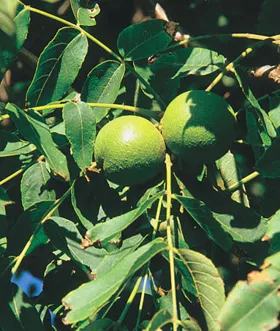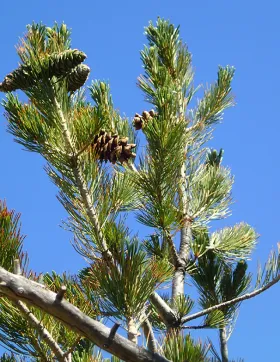Blossom: May
Harvest: early to mid-July
Juneberries are well loved in North Dakota and are known worldwide. They are native to forest edges, prairie hillsides and woody draws. They have long been a part of native human history and are known by many names in North America: Saskatoons, Juneberries, serviceberries, shadblow and shadbush. On the Plains, Juneberries were an important ingredient in pemmican, a blend of berries, dried meat and fat.
Juneberries are a “superfruit.” They are high in antioxidants and fiber. They also are a good source of vitamin E, magnesium and manganese. Blueberries do not grow well in North Dakota due to the more alkaline soil here, but Juneberries answer the need for tasty and nutritious berries on the northern Great Plains.
Juneberries make excellent windbreak shrubs. Their ability to grow in full sun and partial shade makes them a flexible option in designing a multirow windbreak. However, their susceptibility to a range of health problems when stressed limits their use for producing fruit in windbreaks. To survive, they do not require any extra attention once they are established, but to be productive, they likely will need additional care.
Pests and Disease: Juneberries, like apples, can be bothered by a host of insects and diseases. Thinning the plants regularly is important to allow air movement around them and avoid damp soils. Diseases of importance are: Entomosporium leaf and berry spot, juniper-apple rust, fireblight, brown fruit rot, Cytospora canker, powdery mildew and blackleaf. Insect problems include: wooly elm aphids, flower thrips, mites, bud moths, Saskatoon sawflies that burrow into the fruit and pear slug sawflies that eat leaf surfaces. Growing Juneberries organically is very difficult.
Every year, you will fight hungry animals for the Juneberries. Birds, raccoons, deer and even your dog love them. Birds can be kept away with netting placed over the plants in late June.
Characteristics for Windbreak Design
Soil types: prefers loam to sandy loam soil high in organic matter
Light needs: full sun to partial shade; Berry production is higher and foliar diseases less likely in full sun
Water needs: adequate moisture to bear fruit; limited drought-tolerance; does not withstand ponding
Height: 6 to 15 feet
Growth habit: upright, rounded shrub
Life span: moderate-lived; life span highly dependent on site conditions
Juneberries are the northern Midwest’s answer to fresh blueberries. These native berries taste great right off the bush or in your favorite dessert recipes.
Juneberries have an excellent form for windbreaks and can create dense rows that provide shelter year-round.















































